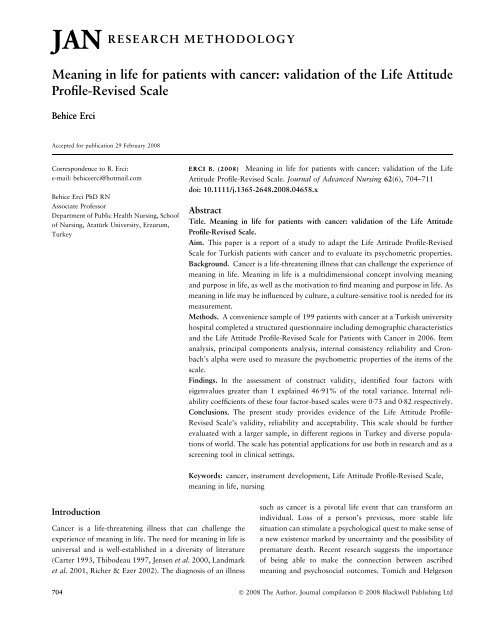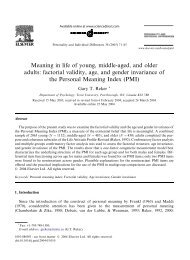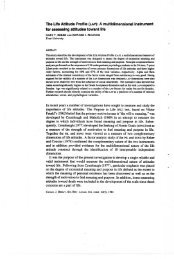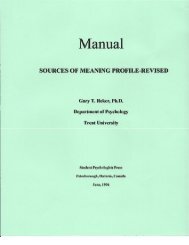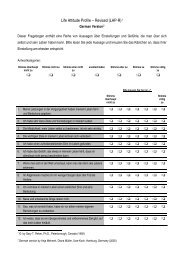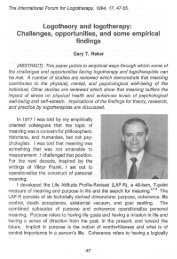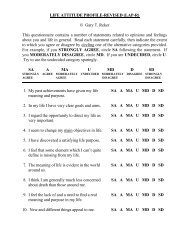Get PDF (68K) - Wiley Online Library
Get PDF (68K) - Wiley Online Library
Get PDF (68K) - Wiley Online Library
You also want an ePaper? Increase the reach of your titles
YUMPU automatically turns print PDFs into web optimized ePapers that Google loves.
JAN<br />
Meaning in life for patients with cancer: validation of the Life Attitude<br />
Profile-Revised Scale<br />
Behice Erci<br />
Accepted for publication 29 February 2008<br />
Correspondence to B. Erci:<br />
e-mail: behiceerci@hotmail.com<br />
Behice Erci PhD RN<br />
Associate Professor<br />
Department of Public Health Nursing, School<br />
of Nursing, Atatürk University, Erzurum,<br />
Turkey<br />
Introduction<br />
RESEARCH METHODOLOGY<br />
Cancer is a life-threatening illness that can challenge the<br />
experience of meaning in life. The need for meaning in life is<br />
universal and is well-established in a diversity of literature<br />
(Carter 1993, Thibodeau 1997, Jensen et al. 2000, Landmark<br />
et al. 2001, Richer & Ezer 2002). The diagnosis of an illness<br />
ERCI B. (2008) Meaning in life for patients with cancer: validation of the Life<br />
Attitude Profile-Revised Scale. Journal of Advanced Nursing 62(6), 704–711<br />
doi: 10.1111/j.1365-2648.2008.04658.x<br />
Abstract<br />
Title. Meaning in life for patients with cancer: validation of the Life Attitude<br />
Profile-Revised Scale.<br />
Aim. This paper is a report of a study to adapt the Life Attitude Profile-Revised<br />
Scale for Turkish patients with cancer and to evaluate its psychometric properties.<br />
Background. Cancer is a life-threatening illness that can challenge the experience of<br />
meaning in life. Meaning in life is a multidimensional concept involving meaning<br />
and purpose in life, as well as the motivation to find meaning and purpose in life. As<br />
meaning in life may be influenced by culture, a culture-sensitive tool is needed for its<br />
measurement.<br />
Methods. A convenience sample of 199 patients with cancer at a Turkish university<br />
hospital completed a structured questionnaire including demographic characteristics<br />
and the Life Attitude Profile-Revised Scale for Patients with Cancer in 2006. Item<br />
analysis, principal components analysis, internal consistency reliability and Cronbach’s<br />
alpha were used to measure the psychometric properties of the items of the<br />
scale.<br />
Findings. In the assessment of construct validity, identified four factors with<br />
eigenvalues greater than 1 explained 46Æ91% of the total variance. Internal reliability<br />
coefficients of these four factor-based scales were 0Æ73 and 0Æ82 respectively.<br />
Conclusions. The present study provides evidence of the Life Attitude Profile-<br />
Revised Scale’s validity, reliability and acceptability. This scale should be further<br />
evaluated with a larger sample, in different regions in Turkey and diverse populations<br />
of world. The scale has potential applications for use both in research and as a<br />
screening tool in clinical settings.<br />
Keywords: cancer, instrument development, Life Attitude Profile-Revised Scale,<br />
meaning in life, nursing<br />
such as cancer is a pivotal life event that can transform an<br />
individual. Loss of a person’s previous, more stable life<br />
situation can stimulate a psychological quest to make sense of<br />
a new existence marked by uncertainty and the possibility of<br />
premature death. Recent research suggests the importance<br />
of being able to make the connection between ascribed<br />
meaning and psychosocial outcomes. Tomich and Helgeson<br />
704 Ó 2008 The Author. Journal compilation Ó 2008 Blackwell Publishing Ltd
JAN: RESEARCH METHODOLOGY Life Attitude Profile-Revised Scale<br />
(2002) compared survivors of breast cancer with agematched<br />
healthy control participants for meaning of life,<br />
but there was little evidence that deriving something positive<br />
from the stressful experience was associated with the quality<br />
of life of survivors or controls.<br />
According to Wong and Fry (1998), meaning in life refers to<br />
‘an individually constructed, culturally based cognitive system<br />
that influences an individual’s choice of activities and goals,<br />
and endows life with a sense of purpose, personal worth, and<br />
fulfilment’. Wong and Fry (1998) argues that the experience of<br />
meaning in life may allow people to transcend intrusive,<br />
negative experiences and promote healthy, positive lives. In<br />
particular, severe losses may function as a trigger for a search<br />
for meaning because they challenge the general human desire<br />
to perceive the world as ordered, predictable and meaningful<br />
(Park et al. 1996, Davis et al. 2000). Patients with cancer have<br />
some specific characteristics that can challenge the experience<br />
of ‘meaning in life’. The illness implies many uncertainties<br />
(e.g. about death, recurrence of the illness) and is accompanied<br />
by losses (e.g. health, job, friends, naturalness of life)<br />
(Alter et al. 1996, Van’t Spijker et al. 1997, Cordova &<br />
Andrykowski 2003, Schroevers et al. 2004).<br />
By better understanding the personal transformation that<br />
occurs in survivors of traumatic and life-threatening circumstances<br />
such as cancer, nurses can assist individuals, particularly<br />
those who may be most vulnerable, to achieve a state<br />
of harmony and balance during and after stressful experiences.<br />
An understanding of the psychological and spiritual<br />
experience of surviving cancer could offer direction for the<br />
development of holistic nursing interventions to enhance<br />
cancer survivors’ quality of life. Most studies of patients with<br />
cancer have concerned quality of life and life satisfaction<br />
(Bauer-Wu & Farran 2005).<br />
Many instruments measuring meaning have been developed<br />
for determining the life experiences of patients with<br />
cancer. Some focus on a single aspect of the construct. Other<br />
measures assess meaning in the context of a negative life<br />
event. Some measures include aspects that have been viewed<br />
as distinct from meaning, and it is unclear whether any<br />
measure offers more construct validity than others. The Life<br />
Attitude Profile–Revised (LAP-R) Scale assesses meaning in<br />
life independent of personal values, and is based on a<br />
conceptualization of meaning in life as a commitment to<br />
goals and one’s feelings of fulfilment (Fife 1995).<br />
Background<br />
Several researchers have reported clinical levels of posttraumatic<br />
stress in patients with cancer (Cordova & Andrykowski<br />
2003, Schroevers et al. 2004). Therefore, it may be that some<br />
people confronted with the diagnosis and treatment of cancer<br />
may be forced to change their former outlook on life, as it<br />
gives no longer enough direction to life. The threat to life can<br />
challenge people’s beliefs about their life and sense of wellbeing.<br />
Positive moods may predispose them to feel that life is<br />
meaningful and may increase their sensitivity to the meaning<br />
relevance of a situation. Issues of meaning and spirituality are<br />
essential components of the experience of people facing<br />
serious illnesses (Folkman & Moskowitz 2000, Breitbart<br />
et al. 2004, Folkman 2008.<br />
Life Attitude Profile-Revised<br />
The LAP-R Scale has been used to measure meaning in life, a<br />
multidimensional concept involving discovered meaning and<br />
purpose in life, as well as the motivation to find meaning and<br />
purpose in life (Reker 1992). The LAP-R Scale was developed<br />
by Reker (1992) in Canada. The LAP-R Scale measures<br />
six dimensions. The first dimension, purpose, refers to<br />
having life goals and a sense of direction from the past, in<br />
the present, and toward the future. The second dimension,<br />
coherence, refers to having an integrated and consistent<br />
understanding of self, others and life. The choice or<br />
responsibleness dimension refers to the perception of freedom<br />
to make life choices. The death acceptance dimension<br />
refers to the absence of fear about death and the acceptance<br />
of death as a natural part of life. The existential vacuum<br />
dimension refers to a lack of meaning in life, lack of goals<br />
and lack of direction. The goal-seeking dimension refers to<br />
the desire to search for new and different experiences. The<br />
six dimensions are used to calculate two composite scales.<br />
The first scale, Personal Meaning Index, is defined as ‘having<br />
life goals, having a mission in life, having a sense of<br />
direction, and having a consistent understanding of self,<br />
others, and life’ (Reker p. 20). It is a composite of the<br />
purpose and coherence subscales of the multidimensional<br />
LAP-R. The LAP-R Scale is a 48-item self-report measure of<br />
discovered meaning and purpose in life and the motivation<br />
to find meaning and purpose in life. Content-related validity<br />
was established through expert consultation, rigorous construct<br />
development and careful review of the literature. Each<br />
item of the LAP-R scale is rated on a 7-point (1–7 anchors)<br />
from 1 (strongly disagree) to 7 (strongly agree) Likert-type<br />
scale of agreement. The LAP-R scale is profiled in terms of<br />
two composite scales. Cronbach’s alpha reliability scores of<br />
the scale were 0Æ79 and 0Æ86 respectively in Reker’s study.<br />
Meraviglia (2004) found that internal consistency reliabilities<br />
for the LAP-R subscales were acceptable except for the<br />
low existential vacuum subscale alpha. Thompson (2007)<br />
determined that Cronbach’s alpha coefficients for the six<br />
Ó 2008 The Author. Journal compilation Ó 2008 Blackwell Publishing Ltd 705
B. Erci<br />
dimensions ranged between 0Æ72–0Æ87 and 0Æ80–0Æ92 for the<br />
composite scales.<br />
Healthcare researchers who work with culturally diverse<br />
communities need to be aware that the measurement of<br />
meaning of life may vary in different cultural groups.<br />
Therefore, the LAP-R may be the best representation of the<br />
constructs of meaning in life from a Turkish perspective, and<br />
thus may be culturally sensitive. Because these commonly<br />
described Turkish cultural values may influence the measurement<br />
of meaning in life, this study was conducted to<br />
determine whether the scale structure of the LAP-R in its<br />
present form taps into these culturally salient values, and thus<br />
whether it is appropriate for use with Turkish patients with<br />
cancer.<br />
The study<br />
Aim<br />
The aim of the study was to adapt the LAP-R Scale for<br />
Turkish patients with cancer and to evaluate its psychometric<br />
properties.<br />
Design<br />
The phases of the study were: (1) translation into the Turkish<br />
language from the English version and back-translation into<br />
English; (2) content analysis by a panel of specialists; and (3)<br />
pre-test and psychometric testing (factor analysis, a reliability<br />
coefficient and inter-item correlations). The data were<br />
collected in 2006.<br />
Participants<br />
The participants were 199 patients with cancer at a university<br />
hospital medical oncology department in Turkey. The<br />
patients were selected through convenience sampling. The<br />
eligibility criteria were: (1) being registered with a primary<br />
diagnosis of cancer in the oncology clinic; (2) aged 18 years<br />
or more, (3) able to read and understand the Turkish<br />
language and (4) no history of psychiatric illness.<br />
Translation procedures<br />
In the first instance, the LAP-R Scale was translated into<br />
Turkish. The Turkish version was then translated into<br />
English by two Turkish lecturers, who worked<br />
independently on the translation. The lecturers both<br />
worked as professors who teach English language at the<br />
Atatürk University. The two translated versions were<br />
compared by the author and analysed until there was a<br />
consensus about the initial translation. Their initial translation<br />
into Turkish was back-translated into English. The<br />
translation phase had the purpose of checking for discrepancies<br />
between the content and meaning of the original<br />
version and the translated instrument. All of the versions<br />
were evaluated by the author and a final version was<br />
formed.<br />
Content validity<br />
To test item clarity and content validity, the translated<br />
version was submitted to a panel of seven specialists. They<br />
were informed about the measures and concepts involved by<br />
the author. This multidisciplinary panel comprised two<br />
public health specialists, two experts who had published<br />
papers on cancer and three nurses who had conducted<br />
research in the oncology. Each of the panel members was<br />
asked to evaluate the content of the final translated version of<br />
the LAP-R Scale compared to the original instrument. The<br />
experts were asked to evaluate each item at the scale using a<br />
7-point Likert Scale: 7 = strongly agree, 6 = agree, 5 = moderately<br />
agree, 4 = undecided, 3 = moderately disagree,<br />
2 = disagree, 1 = strongly disagree.<br />
Pre-test<br />
The final version of the translated instrument was pre-tested<br />
with a pilot group of 30 patients from the medical oncology<br />
clinics. The pre-test was conducted at the outpatient and<br />
inpatient medical oncology clinics where the main study was<br />
to be carried out. To simplify the recording of doubts and<br />
suggestions about the scale, a questionnaire was used,<br />
requesting general information from the interviewee, such<br />
as gender, age, civil status and occupation. An open-ended<br />
question to record doubts and suggestions was provided for<br />
each of the items.<br />
Data collection<br />
The researcher visited the oncology clinic on five working<br />
days in every week and conducted interviews with the<br />
patients. The questionnaire was explained to the participants,<br />
who then read it and marked their answers on the<br />
sheets. The questionnaire took approximately 20 minutes to<br />
complete and could be understood by people with minimal<br />
reading ability. It was given to patients in a separate quiet<br />
room in the oncology clinic. All participants completed the<br />
questionnaire. Test–retest of the scale was conducted after<br />
4 weeks.<br />
706 Ó 2008 The Author. Journal compilation Ó 2008 Blackwell Publishing Ltd
JAN: RESEARCH METHODOLOGY Life Attitude Profile-Revised Scale<br />
Ethical considerations<br />
The study was approved by the ethics committee at the<br />
Health Science Institute of Atatürk University and informed<br />
consent was obtained from each participant. The patients<br />
were informed about the purpose of the research, and assured<br />
of their right to refuse to participate or to withdraw from the<br />
study at any stage. Anonymity and confidentiality were<br />
guaranteed.<br />
Data analysis<br />
Internal consistency and homogeneity<br />
Cronbach’s alpha was calculated to determine internal consistency.<br />
Clark and Watson (1995) indicated that internal<br />
consistency may be a necessary condition for homogeneity or<br />
unidimensionality of a scale and Cronbach’s alpha should be<br />
0Æ70 or higher. Item-total correlations and mean inter-item<br />
correlations were included in the analysis. Clark and Watson<br />
(1995) recommend using the inter-item correlation as a criterion<br />
for internal consistency. This should be 0Æ15 or higher<br />
for independent and dependent samples of 30 and above.<br />
They pointed out that this average value could be biased and<br />
all individual inter-item correlations should be r =0Æ15–0Æ50.<br />
Unidimensionality can only be assured if all individual interitem<br />
correlations are clustered closely around the mean interitem<br />
correlation.<br />
Construct validity<br />
The data were analysed using factor analysis (principal<br />
component analysis and varimax rotation). To attain the best<br />
fitting structure and the appropriate number of factors, the<br />
following criteria were used: eigenvalues higher than 1Æ0,<br />
factor loadings higher than 0Æ40 and the so-called elbow<br />
criterion for the eigenvalues (De Heus et al. 1995). Before<br />
conducting the factor analysis, the Kaiser–Meyer–Olkin<br />
(KMO) measure of sampling adequacy and Bartlett’s test<br />
were calculated to evaluate whether the sample was large<br />
enough to perform a satisfactory factor analysis. The KMO<br />
measures the sampling adequacy and the P value should be<br />
greater than 0Æ05 for a satisfactory factor analysis to proceed.<br />
Results<br />
Participant demographics<br />
The demographic and disease/treatment characteristics of the<br />
participants were shown in Table 1. The majority of the<br />
sample was at stage-II of cancer, 92Æ0% were married and<br />
44Æ2% had graduated from primary school. The mean<br />
Table 1 The demographic and disease/treatment characteristics of<br />
the participants (n = 199)<br />
Demographic characteristics X ± SD<br />
Diagnosis duration (years) 3Æ5 ± 2Æ8<br />
Age (years) 52Æ2 ± 13Æ9<br />
Monthly income of family (US$)* 476Æ6 ± 262Æ9<br />
The number of children 5Æ4 ± 3Æ0<br />
n %<br />
Gender<br />
Women 93 46Æ7<br />
Men 106 53Æ2<br />
Education level<br />
B. Erci<br />
Turkish instrument were made and discussed each time by<br />
the panel members until agreement about the content was<br />
reached. The panel then reviewed the content of Turkish<br />
version until there was no further need to modify its<br />
translation and content.<br />
Internal consistency<br />
The LAP-R Scale was found to have an overall coefficient<br />
alpha of 0Æ71. Alphas of the four factors ranged from 0Æ73 to<br />
0Æ82 (see Table 2). However, Cronbach’s alphas of the two<br />
dimensions of death acceptance and existential vacuum were<br />
less than 0Æ70, and these dimensions were removed from the<br />
scale. The corrected item-total correlations were acceptable,<br />
except for one item (15), and the item-total correlations<br />
ranged from 0Æ29 to 0Æ72 for the remaining 47 items.<br />
Construct validity<br />
The calculated KMO was 0Æ76 with a P value
JAN: RESEARCH METHODOLOGY Life Attitude Profile-Revised Scale<br />
Table 2 Principal components analysis followed by varimax rotation factor loadings and item-total correlations of items of the scale (n = 199)<br />
Items of the scale and the items of factors<br />
self may likewise influence presence of meaning. In addition,<br />
people in Turkish society have a fatalist approach to the<br />
events or, in other words, a subservient approach, because of<br />
their religious beliefs. Moreover, the majority of the sample<br />
in this study had low education level and the patients with<br />
low educational level may be particularly vulnerable. This<br />
may explain the Cronbach’s alphas of less than 0Æ70 for two<br />
factors in the present study.<br />
When the items in the Turkish scale were compared to the<br />
original scale, there were differences between them. The<br />
KMO was calculated and found to be 0Æ76, indicating that<br />
Factor<br />
loading<br />
Item-total<br />
correlations Alpha<br />
Variance<br />
(%)<br />
Factor 1: Purpose 0Æ73 23Æ25<br />
1. My past achievements have given my life meaning and purpose 0Æ332 0Æ419***<br />
2. In my life I have very clear goals and aims 0Æ561 0Æ477***<br />
5. I have discovered a satisfying life purpose 0Æ416 0Æ299**<br />
18. Basically, I am living the kind of life I want to live 0Æ625 0Æ663***<br />
26. I know where my life is going in the future 0Æ600 0Æ705***<br />
31. In achieving life’s goals, I have felt completely fulfilled 0Æ474 0Æ672***<br />
37. I have a mission in life that gives me a sense of direction 0Æ632 0Æ584***<br />
48. My life is running over with exciting good things 0Æ486 0Æ625***<br />
Factor 2: Coherence 0Æ77 9Æ50<br />
7. The meaning of life is evident in the world around us 0Æ380 0Æ420***<br />
12. I have been aware of an all powerful and consuming purpose<br />
towards which my life has been directed<br />
0Æ522 0Æ618***<br />
27. In thinking of my life, I see a reason for my being here 0Æ531 0Æ721***<br />
29. I have a framework that allows me to understand or make sense of my life 0Æ517 0Æ674***<br />
35. I have the sense that parts of my life fit together into a unified pattern 0Æ484 0Æ456***<br />
38. I have a clear understanding of the ultimate meaning of life 0Æ573 0Æ607***<br />
46. My personal existence is orderly and coherent 0Æ432 0Æ614***<br />
Factor 3: Choice/Responsibleness 0Æ82 7Æ91<br />
3. I regard the opportunity to direct my life as very important 0Æ540 0Æ672***<br />
11. My accomplishments in life are largely determined by my own efforts 0Æ656 0Æ672***<br />
17. I determine what happens in my life 0Æ500 0Æ670***<br />
19. Concerning my freedom to make my choice, I believe I am absolutely<br />
free to make all life choices<br />
0Æ523 0Æ687***<br />
23. It is possible for me to live my life in terms of what I want to do 0Æ484 0Æ602***<br />
30. My life is in my hands and I am in control of it 0Æ587 0Æ691***<br />
39. When it comes to important life matters, make my own decisions 0Æ484 0Æ710***<br />
45. I accept personal responsibility for the choices I have made in my life 0Æ405 0Æ611***<br />
Factor 4: Goal Seeking 0Æ80 6Æ25<br />
10. New and different things appeal to me 0Æ472 0Æ668***<br />
14. I would enjoy breaking loose from the routine of life 0Æ349 0Æ630***<br />
24. I feel the need for adventure and ‘‘new worlds to conquer’’ 0Æ652 0Æ727***<br />
34. A new challenge in my life would appeal to me now 0Æ544 0Æ604***<br />
36. I hope for something exciting in the future 0Æ606 0Æ685***<br />
41. I am eager to get more out of life than I have so far 0Æ429 0Æ666***<br />
43. I am determined to achieve new goals in the future 0Æ451 0Æ633***<br />
Total 0Æ71 46Æ91<br />
**P < 0Æ01.<br />
***P < 0Æ001.<br />
the sample was large enough to perform a satisfactory factor<br />
analysis and that further validation (factor solution) could<br />
progress with a similar sample size. Sample size in this study<br />
was adequate for factor analysis.<br />
Factor analysis showed that all of factor loadings were<br />
above 0Æ30 and factor loading of the items ranged 0Æ32–0Æ65.<br />
Factor loadings have not been reported in other study of the<br />
scale (Reker 1992, Vickberg et al. 2001, Bauer-Wu & Farran<br />
2005). The acceptable minimum point for factor loading is<br />
0Æ30 (Burns & Grove 1993); in this study all items met these<br />
criteria and factor loadings were high.<br />
Ó 2008 The Author. Journal compilation Ó 2008 Blackwell Publishing Ltd 709
B. Erci<br />
What is already known about this topic<br />
• Meaning in life has implications for patients with<br />
cancer.<br />
• The Life Attitude Profile-Revised Scale has been found<br />
to be a valid measure in only a few populations. Crosscultural<br />
influences on meaning in life in patients with<br />
cancer influence the reliability of the scale.<br />
What this paper adds<br />
• The Life Attitude Profile-Revised Scale may be a valid<br />
measure for Turkish patients with cancer.<br />
• The Turkish version of the Life Attitude Profile-Revised<br />
Scale shows statistically acceptable levels of reliability<br />
and validity.<br />
• Further research is needed to evaluate the scale with<br />
larger populations and in other regions of Turkey.<br />
Test–retest reliability of the scale was 0Æ76. Vickberg et al.<br />
(2001) reported a test–retest reliability of 0Æ90. According to<br />
the present results, therefore, the scale had construct validity.<br />
Study limitations<br />
The findings must be interpreted cautiously because of the<br />
study limitations. Face validity was not tested with a panel of<br />
patients themselves and most of the patients low education<br />
levels (Literate 32Æ7%, primary school 44Æ2%).<br />
The sample reflects only one area of Turkey and therefore<br />
cannot be generalized to all patients with cancer in Turkey.<br />
Future studies should include larger samples from different<br />
regions in Turkey.<br />
Conclusion<br />
The Turkish version of the LAP-R Scale should be further<br />
evaluated with a large sample size in different regions of<br />
Turkey and diverse populations in other in different cultures.<br />
Further validation of the Turkish version is needed to allow<br />
its use in research and clinical practice.<br />
References<br />
Alter C.L., Pelcovitz D., Axelrod A., Goldenberg B., Haris H.,<br />
Meyers B., Grobois B., Mandel F., Septimus A. & Kaplan S. (1996)<br />
Identification of PTSD in cancer survivors. Psychosomatics 37,<br />
137–143.<br />
Bauer-Wu S. & Farran C.J. (2005) Meaning in life and<br />
psycho-spiritual functioning: a comparison of breast cancer<br />
survivors and healthy women. Journal of Holistic Nursing 23,<br />
172–190.<br />
Baumeister R.F. (1991) Meanings of Life. Guilford, New York.<br />
Breitbart W., Gibson C., Poppito S.R. & Berg A. (2004) Psychotherapeutic<br />
interventions at the end of life: a focus on meaning and<br />
spirituality. Canadian Journal of Psychiatry 49, 366–372.<br />
Burns N. & Grove S.K. (1993) The Practice of Nursing Research<br />
Conduct, Critique and Utilization, 2nd edn. W.B. Saunders Company,<br />
Philadelphia.<br />
Carter B.J. (1993) Long-term survivors of breast cancer. Cancer<br />
Nursing 16, 354–361.<br />
Clark L.A. & Watson D. (1995) Constructing validity: basic issues in<br />
objective scale development. Psychological Assessment 7, 309–<br />
319.<br />
Cordova M.J. & Andrykowski M.A. (2003) Responses to cancer<br />
diagnosis and treatment: posttraumatic stress and posttraumatic<br />
growth. Seminars in Clinical Neuropsychiatry 8, 286–296.<br />
Davis C.G., Wortman C.B., Lehman D.R. & Silver R.C. (2000)<br />
Searching for meaning in loss: are clinical assumptions correct?<br />
Death Studies 24, 497–540.<br />
De Heus P., Van der Leeden R. & Gazendam B. (1995) Toegepaste<br />
data-analyse: Technieken voor niet-experimenteel onderzoek in de<br />
sociale wetenschappen (Applied data analysis for non-experimental<br />
techniques in the social sciences). Lemma, Utrecht.<br />
Erefe _ I. (2002) Veri toplama araçlarının nitelig˘i. In Hems¸irelikte<br />
Aras¸tırma (Erefe _ I., ed), Odak Ofset, _ Istanbul, pp. 169–188.<br />
Fife B.L. (1995) The measurement of meaning in illness. Social<br />
Science & Medicine 40, 1021–1028.<br />
Folkman S. (2008) The case for positive emotions in the stress process.<br />
Anxiety, Stress, and Coping 21(1), 3–14.<br />
Folkman S. & Moskowitz J.T. (2000) Positive affect and the other<br />
side of coping. American Psychologist 55(6), 647–654.<br />
Jensen K.P., Bäck-Pettersson S. & Segesten K. (2000) The meaning of<br />
‘‘not giving in’’: lived experiences among women with breast<br />
cancer. Cancer Nursing 23, 6–11.<br />
Kitayama S. & Markus H.R. (2000) The pursuit of happiness and the<br />
realization of sympathy: cultural patterns of self, social relations,<br />
and well-being. In Culture and Subjective Wellbeing (Diener E. &<br />
Suh E.M., eds), MIT Press, Cambridge, MA, pp. 113–161.<br />
Landmark B.T., Standmark M. & Wahl A.K. (2001) Living with<br />
newly diagnosed breast cancer: the meaning of existential issues.<br />
Cancer Nursing 24, 220–226.<br />
Meraviglia M.G. (2004) The effects of spirituality on well-being<br />
of people with lung cancer. Oncology Nursing Forum 31(1),<br />
89–94.<br />
Nisbett R.E., Peng K., Choi I. & Norenzayan A. (2001) Culture and<br />
systems of thought: holistic vs. analytic cognition. Psychological<br />
Review 108, 291–310.<br />
Park C.L., Cohen L.H. & Murch R.L. (1996) Assessment and prediction<br />
of stress-related growth. Journal of Personality 64, 71–105.<br />
Polit D.F. & Beck C.T. (2004) Nursing Research: Principles and<br />
Methods, 7th edn. Lippincott Williams & Wilkins, Philadelphia,<br />
PA.<br />
Reker G.T. (1992) Life Attitude Profile [Rev. manual]. Student<br />
Psychologists, Peterborough, Ontario, Canada.<br />
Richer M.C. & Ezer H. (2002) Living in it, living with it, and moving<br />
on: dimensions of meaning during chemotherapy. Oncology<br />
Nursing Forum 29, 113–119.<br />
710 Ó 2008 The Author. Journal compilation Ó 2008 Blackwell Publishing Ltd
JAN: RESEARCH METHODOLOGY Life Attitude Profile-Revised Scale<br />
Schroevers M.J., Ranchor A.V. & Sanderman R. (2004) The role of<br />
age at the onset of cancer in relation to survivors’ long term<br />
adjustment: a controlled comparison over an eight year period.<br />
Psycho-oncology 13, 740–752.<br />
Thibodeau J. (1997) Breast cancer survival: a phenomenological<br />
inquiry. Advanced Nursing Science 19, 65–74.<br />
Thompson P. (2007) The relationship of fatigue and meaning in life<br />
in breast cancer survivors. Oncology Nursing Forum 34(3), 653–<br />
660.<br />
Tomich P.L. & Helgeson V.S. (2002) Five years later: a cross-sectional<br />
comparison of breast cancer survivors with healthy women.<br />
Psycho-oncology 11, 154–169.<br />
Van’t Spijker A., Trijsburg R.W. & Duivenvoorden H.J. (1997)<br />
Psychological sequelae of cancer diagnosis: a metaanalytical<br />
review of 58 studies after 1980. Psychosomatic Medicine 59,<br />
280–293.<br />
Vickberg S.J., Duhamel K.N., Smith M.Y., Manne S.L., Winkel G.,<br />
Papadopoulosd E.B. & Redd W.H. (2001) Global meaning and<br />
psychological adjustment among survivors of bone marrow transplant.<br />
Psycho-oncology 10, 29–39.<br />
Wong P. & Fry P. (1998) The Human Quest for Meaning: A<br />
Handbook of Psychological Research and Clinical Applications.<br />
Lawrence Erlbaum Associates, Inc., Publishers, Mahwah, NJ.<br />
Ó 2008 The Author. Journal compilation Ó 2008 Blackwell Publishing Ltd 711


